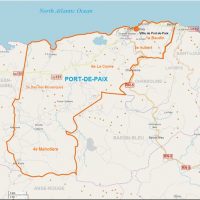Port-De-Paix

Port-de-Paix is capital of the Northwest Department and chief city of the Port-de-Paix Arrondissement.
Port-de-Paix is Haiti’s fourth largest state capital and its tenth most populous city. French insurrectionists established the coastal metro area in 1665. The Port-de-Paix Arrondissement is made up of four communes: Port-de-Paix, Bassin-Bleu, Chansolme, and Tortuga Island.
The city was initially discovered in 1492 by Christopher Columbus, who called it Valparaiso. The French, who had settled Saint-Domingueduring the 1600s, made Port-de-Paix its capital after they had been ousted from Tortuga Island by the British. In 1679 Port-de-Paix witnessed the initial black slave uprising, which was to last a decade. By the 19th century, Port-de-Paix was prospering. However, in 1902 a fire broke out and raged through the city, completely demolishing it. Since that time, it has never made a full recovery.
Port-de-Paix, chief place of the North West Department, was raised to the rank of commune in 1812. In the old days of the Spanish, this commune was called Valparaiso. After the departure of the Spaniards in favor of many changes that have taken place, it took the name of “Port-de-Paix” which it has preserved to this day. This commune has seven communal sections. The inhabitants of the commune are called Port-de-Paisien. The relief of the commune of Port-de-Paix is dominated by hills, plateaus and plains. Its climate varies from normal to cool according to its geographical position which is both coastal and inland. The municipality of Port-de-Paix has an area of 401.54 km2. Its population was estimated at 105 767 inhabitants in 1998 and projections placed it at 121 000 in 2004. The urban section of Port-de-Paix has an area of 8 km2 (3 Square miles) and a density of 15,501 people per km2 (40,407 people per Square mile).
With regard to economic and financial establishments, the commune of Port-de-Paix is better equipped than the others. It has three banks, however, it does not have a Caisse populaire. There are also hotels, a pension, about a dozen restaurants, two home centers and a marketing cooperative.
A rich agricultural area, it grows coffee, bananas, tobacco, rice, and cacao. Because the city is so accessible to the U.S. via the Atlantic, a flourishing smuggling trade has developed in Port-de-Paix since the 1990s.
Transportation: Port-de-Paix’s transportation infrastructure is well developed, being served by many regional airlines. They offer flight service from Port-de-Paix Airport to Toussaint Louverture International Airport, located in Port-au-Prince, and to Cap-Haitien International Airport in Cap-Haïtien. A ferry operation carries tourists between the beautiful beaches of Port-de-Paix and Tortuga Island.
Education: The Ministry of the National Education of Youth and Sport is represented in the municipality by a departmental direction. The person in charge is a departmental director responsible for supervising his activities. Assisted by its staff, it coordinates certain activities and establishes a plan of operation concerning the different schools within this municipality. The distribution of schools is as follows Five private school at the kindergarten level and at the primary level 11 public schools, numerous private, and 6 congregational. For the secondary level there are two Public Schools numerous private schools and one Congregational School.
Healthcare: The Ministry of Public Health and Population is represented in the commune of Port-de-Paix by a departmental directorate. For health care facilities there are two non-bed health centers, two hospitals, 13 clinics and three medical laboratories. In addition, a team consisting of doctors and dentists, nurses and auxiliaries, many certified matrons and a dozen laboratory technicians, provide the health service at the various health centers of the municipality.
Utilities: As for water availability, five rivers, two dozen Springs and a pond were inventoried in the municipality. For the other water points, eight artesian wells, public fountains with at least 25 taps and also three pumps were recorded. The water coming from the public fountains is the most used. It is used for domestic use and especially for drinking. About Electricity, a large part of the commune of Port-de-Paix is electrified. The HRE is the institution responsible for electricity in this commune. It provided an average of 56 hours/week.
Security: With regard to administrative and judicial infrastructures, the commune of Port-de-Paix has a peace court, in the city at Rue Dumarsis Estime. There is also a prison.
Religion: With respect to Religion, more than 100 temples of all faiths were counted in the commune of Port-de-Paix. These confessions are: Catholics, Adventist Baptists, Pentecostal and Jehovah’s Witnesses. The number of Pentecostal temples and churches of God is better represented are 44% of the total.
Organizations: With regard to the political parties and organizations that have gone through the city and the communal sections, there are seven political parties, 34 popular organizations, six peasant groups, thirteen Women’s groups, three non-commercial cooperatives, six NGOs and four International organizations.
Communication: In terms of Communication, the municipality of Port-de-Paix has no “newspapers/journals” but has seven radio stations and a television station.
In Port-de-Paix, radio stations abound, many of them FM, and a few broadcast over the Internet. Fans of Compás in Port-de-Paix favor such music artists as Shoubou de Tabou Combo, Cubano de Skah Shah, and Drumcp.
Leisure: As for leisure, the Gaguères, numbering six, constitute the main places of distraction for the inhabitants of the commune. For other types of entertainment, four football (soccer) fields, two basketball courts that are in poor condition, a Theatre room and six night clubs have been inventoried at the level of this municipality.

